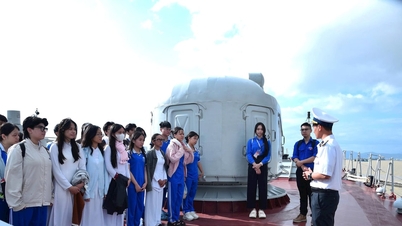The 25-kilometer-high Olympus Mons volcano on Mars may have once been located in the middle of a vast ocean.

The Olympus Mons volcano is located on the surface of Mars. Photo: CNRS
When Mars was young and wet billions of years ago, the massive volcano Olympus Mons may have resembled Earth's Stromboli or Savai'i volcanoes, but on a much larger scale. New analysis published in the journal Earth and Planetary Science Letters points to many similarities between Olympus Mons and active volcanic islands on Earth, providing further evidence of Mars' water-bearing past, Science Alert reported on July 27.
According to a research team led by geologist Anthony Hildenbrand at the University of Paris-Saclay in France, the upper rim of the 6-kilometer-high steep cliffs surrounding Olympus Mons was most likely formed by lava flowing into liquid water when the structure was an active volcanic island around the late Noachian and early Hesperian periods.
Olympus Mons is a 25-kilometer-high shield volcano, spanning an area roughly the size of Poland. It is not only the largest volcano but also the tallest mountain in the solar system. However, its base does not meet the ground as a gentle slope. Instead, at an altitude of approximately 6 kilometers, a sheer cliff surrounds much of its perimeter, plunging directly down to the surface below. The origin of this steep slope remains a mystery.
Today, Mars is barren and dusty. Water on the planet's surface exists only in the form of ice; there are no rivers or oceans covering vast basins and craters. But researchers are increasingly finding evidence suggesting that Mars once contained a great deal of liquid water. Gale Crater, where the Curiosity rover is operating, may have once been a vast lake billions of years ago.
Hildenbrand and colleagues used this data to reconstruct the environment around Olympus Mons. They examined similar shield volcanoes on Earth. Specifically, they studied three volcanic islands: Pico Island in Portugal, Fogo Island in Canada, and Hawaii in the United States. The research team found that the coastlines of these islands have steep cliffs, similar to the cliffs surrounding Olympus Mons. On Earth, such steep cliffs result from changes in the viscosity of lava due to temperature differences when it transitions from air to water. Therefore, the researchers speculated that Olympus Mons was once a volcanic island surrounded by liquid water.
According to the research team, the height of the steep cliffs could represent the sea level of a now-vanished ocean. The period of lava flows, 3-3.7 billion years ago, was when the ocean existed. "Future spacecraft specializing in collecting samples or autonomous robots capable of dating at several locations on Olympus Mons promise significant research potential," Hildenbrand and colleagues concluded.
An Khang (According to Science Alert )
Source link



![[Photo] Prime Minister Pham Minh Chinh presides over the conference announcing the establishment of the International Finance Centre in Vietnam.](/_next/image?url=https%3A%2F%2Fvphoto.vietnam.vn%2Fthumb%2F1200x675%2Fvietnam%2Fresource%2FIMAGE%2F2025%2F12%2F21%2F1766309817714_ndo_br_dsc-3400-jpg.webp&w=3840&q=75)


![[Photo] Prime Minister Pham Minh Chinh presides over a meeting on private sector economic development.](/_next/image?url=https%3A%2F%2Fvphoto.vietnam.vn%2Fthumb%2F1200x675%2Fvietnam%2Fresource%2FIMAGE%2F2025%2F12%2F20%2F1766237501876_thiet-ke-chua-co-ten-40-png.webp&w=3840&q=75)


































































































Comment (0)